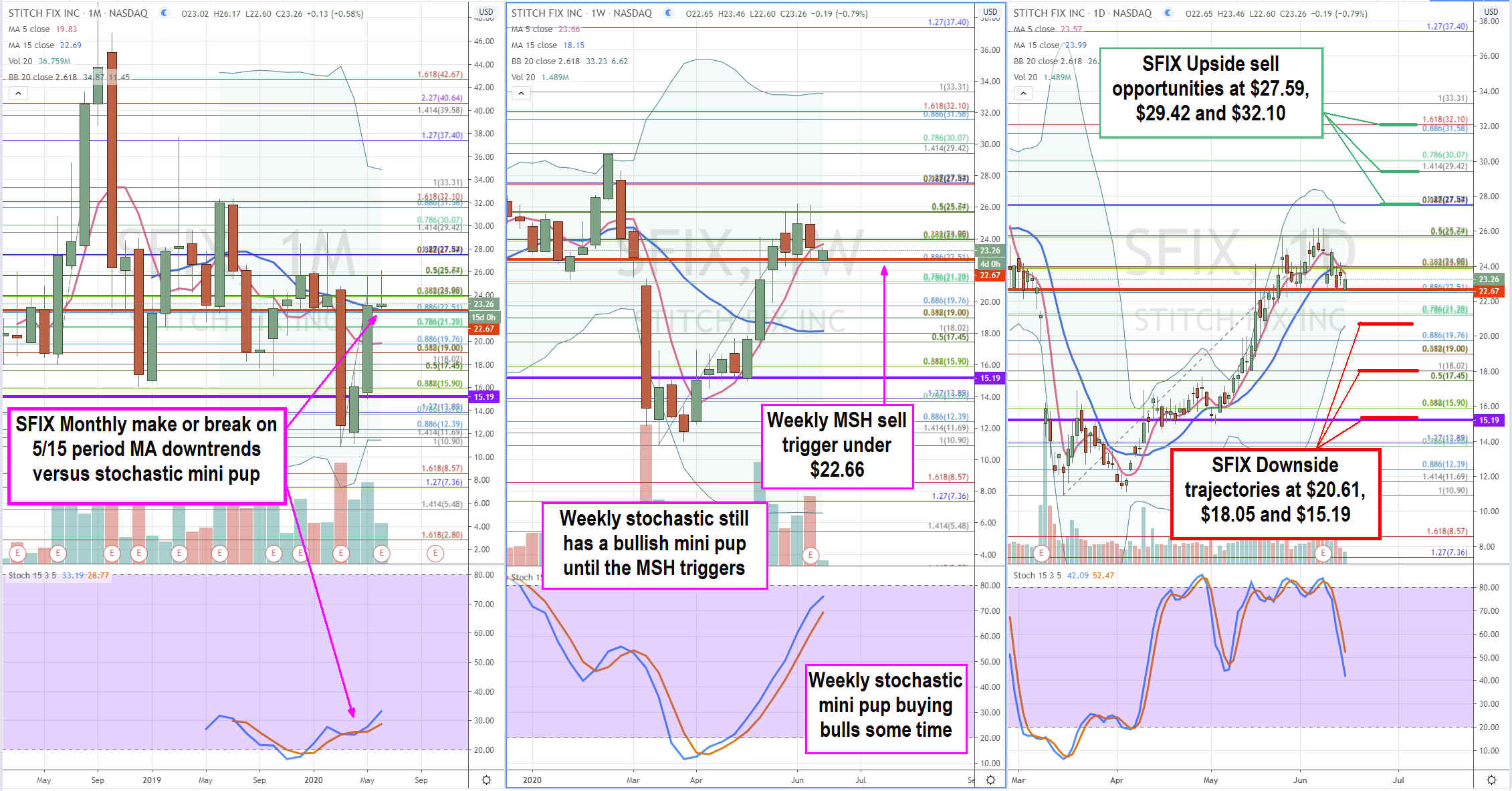Online custom wardrobe stylist service
Stitch Fix (NASDAQ: SFIX) shares staged a rally with the
S&P 500 index (NYSEARCA: SPY) off their lows made in March 2020. Stitch Fix was able to recover close to its pre-COVID-19 highs made in February of $29.42 peaking at $26.11. This was an impressive recovery off the $10.90 low made on Mar. 16, 2020. As an online commerce play, investors assumed the business would experience a nice surge due to the national stay-at-home restriction mandates that drove online e-commerce retailers like Amazon (
NASDAQ: AMZN), Wayfair (
NYSE: W),
Shopify (
NASDAQ: SHOP),
eBay (
NASDAQ: EBAY) and Overstock (
NASDAQ: OSTK) to reach new 2020 highs as pandemic beneficiary stocks. Unfortunately, the Q3 FY2020 earnings results revealed that Stitch Fix was neither a pandemic benefactor nor a restart narrative player. It was simply a “pretender” as they faced supply chain issues, demand shock and thinning margins. Investors may want to consider unwinding shares into the recent and potential higher run up into the upside trajectory levels before the next earnings release.
Q3 FY2020 Earnings Fallout
Stich Fix reported their Q3 fiscal 2020 earnings for the quarter ending in April 2020 on June 8, 2020. The Company reported a loss of (-$0.33)-per share compared to (-$0.14)-per share consensus analyst estimates, missing by (-$0.19) per share. Revenues actually fell to $71.7 million versus $414.54 million consensus analyst estimates, a (-9.1%) year-over-year (YoY) drop. Active clients grew 9% YoY to 3.4 million as net revenue per active client rose 6% to $98. The Company has $329 million in cash and investments. As an e-commerce play, the market had high expectations for stronger top and bottom-line results. The story fits the internet commerce platform narrative of being asset-light and connecting customers with over 5,100 stylists using sophisticated machine learning technology through its team of over 100 data scientists to make perfect matches. What could go wrong? The bar was set high and Stitch Fix missed it especially in light of the current “sell the news” reaction template that applies even for stocks that handily beat analyst estimates.
Pandemic Pretender or Restart Winner?
Upon further analysis, the miss is understandable since consumers stuck at home don’t tend to shop for clothes much less customized wardrobes assembled by stylists. Investors still sticking around may be anticipating the surge in business when offices reopen, and social engagement returns as stay-in-shelter mandates get relaxes and pulled. This is a viable thesis that could play out. However, due to the slumping business, the Company could be facing the closure of several of their warehouses. While the algorithms match up customers to stylists, the product is the apparel products of which some of the inhouse brands and many are third-party brands. Any supply chain issues with third-party brands as well as their own manufacturing capacity for inhouse brands can punch a hole straight through the middle of the operating strategy. The other factor that must be considered is the record jobless and unemployment claims wreaking havoc on family budgets. Fancy clothing and apparel are discretionary products that are secondary to staples like food. The reopening of offices and the recovery of the employment market and consumer discretionary spending are all factors in Stitch Fix business model. This mountain may be too high to climb as the company is fight time with only $96.8 million in cash. This is the lowest YoY cash position the Company has held in since 2017. Investors should monitor the price trajectories to take advantage of the “gift” stock spikes to avoid getting trapped in the overhang.

Price Trajectories
Using the rifle charts on a monthly, weekly and daily time frame provides a broader view of the landscape for SFIX stock. The monthly rifle chart displays a make or break with a bullish stochastic versus a moving average downtrend. The weekly rifle chart triggered a market structure low (MSL) above a the $15.19. This triggered the weekly bullish mini pup on a breakout through the $17.45 Fibonacci (fib) level. This combined with the daily and stochastic mini pups triggered a perfect storm that spiked shares to the recent highs at $26.11. The earnings fallout sold off shares to the $22.67 weekly lows, which sets the weekly market structure high (MSH) sell trigger under $22.66. The upside trajectories if the daily stochastic can cross back up which monthly and weekly carry simultaneous rising stochastic sits at the $27.52, $29.52 and $32.10 best-case upper weekly Bollinger Bands (BBs). Investors should monitor and track the bull case to pick the best spots to unwind. The bear case triggers under the $22.66 weekly MSH setting up downside trajectories to the $20.61 daily lower BBs, $18.05 weekly 15-period MA and $15.19 weekly MSL trigger. Short sellers will want to monitor the bear case price levels to gauge the coil responses and follow-through.
Before you make your next trade, you'll want to hear this.
MarketBeat keeps track of Wall Street's top-rated and best performing research analysts and the stocks they recommend to their clients on a daily basis.
Our team has identified the five stocks that top analysts are quietly whispering to their clients to buy now before the broader market catches on... and none of the big name stocks were on the list.
They believe these five stocks are the five best companies for investors to buy now...
See The Five Stocks Here
Explore Elon Musk’s boldest ventures yet—from AI and autonomy to space colonization—and find out how investors can ride the next wave of innovation.
Get This Free Report
Like this article? Share it with a colleague.
Link copied to clipboard.